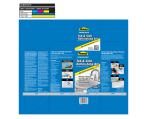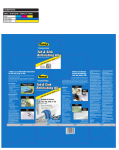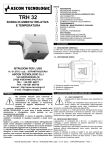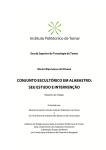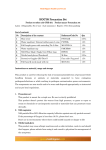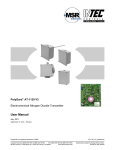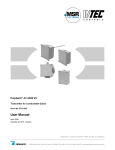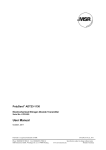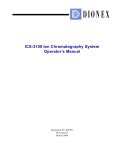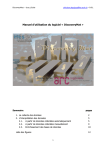Download Illustrated Work Flow --- Conservation Treatment of Metallic Artifacts
Transcript
Illustrated Work Flow Conservation Treatment of Metallic Artifacts Conservation Treatment of Metallic Artifacts The basic aims of conservation treatment of metallic artifacts are to remove the oxidizing elements, to consolidate fragile structure due to corrosion, and, in case the original metal is retained, to form a film of synthetic resin to stop further oxidization. Even after the conservation treatment, oxidization can recur under an imperfect coating or in an inadequate storage environment. This point should be clearly understood. For X-ray photography or an analysis using radiation, extra care is required for avoiding exposure to the body. Under Japanese laws a national qualification is required for the use of X-ray, and operation must be always conducted under the supervision of a qualified personnel. The use of large amount of organic solvent for conservation treatment also requires strict control of fire, as it is highly volatile as well as flammable. Since it is also hazardous to the body (some are dermally absorbed) and adversely affects the mucous membranes in the short run, and nervous system in the long run, remember always to wear a gas mask and a pair of solvent-resistant gloves, and to ventilate the workspace. The used solvents must be detoxified before disposal, for protection of cultural property does not justify the environmental damage. Sharp appliances must be handled with utmost care as well. Below is the workflow of conservation treatment for iron and bronze artifacts. >Device and materials required< - Acrylic resin (non-water type acrylic emulsion) - Epoxy resin -BTA Note: Benzotriazole (BTA)…C6H5N3. Boiling point at 98.5°C. It is a white crystal in powder form, and is believed to curb the development of corrosion on bronze objects. Although no decisive data is available, it is believed to be carcinogenic from its chemical structure (C=N). It is desirable not to inhale it in powder form at preparation, not to put it on the skin when handling it in solution, and always to wear a gas mask with an organic vapor canister when using it in the form of resin spray. chemical structure - Organic solvent - Desalination solution: Lithium hydroxide (LiOH), alcohol solution, potassium carbonate (K2CO3), sodium hydroxide (NaOH), sodium sesquicarbonate (Na2CO3・NaHCO3) solutions - Stainless steel bath - Vacuum impregnation tank - Vacuum oven - Radiography apparatus and development facility - X-ray films - Suction apparatus (against diffusion of dust) - Dryer - Silkscreen - File, surgical knife, nipper and dental grinder - Tweezer - Chemical proof gloves, solvent proof gloves and fabric gloves - Gas mask and dust mask 1 Pre-examination Take a photo and prepare for a sketch drawing of the artifact to record its status. Conduct radiography to confirm the deterioration level of the areas that visual observation fails to capture, and to understand the inner structure. With the presence of different metal(s) as ornaments, an X-ray photo can contribute to the pre-examination great deal by capturing their shapes. Also, even with modern high-precision analytical devices, it is more desirable to conduct a composition analysis of parts like ornaments at this stage for greater accuracy of result, because a film of synthetic resin may generate some variance in the result of the analysis. Radiography 1.Follow the user’s manual to age the radiography appliance before use, in order not to apply sudden voltage load on the appliance. For the same purpose, it is also advisable to rest the appliance for the same length of time as it irradiates X-ray during use. 2. In a dark room, insert a X-ray film between X-ray intensifying screens and place it in a film cassette. The black lightproof bag (container of the film) can replace the film cassette. Note: X-ray intensifying screen: A sheet applied with fluorescent material on its surface for exposing X-ray images onto the film. When X-ray is irradiated onto the phosphors on the sheet, it converts the energy to light. This light is used to sensitize the film to capture the image at a lower voltage. 3. Set the artifact in the radiography apparatus, and irradiate the X-ray. adjusted, The intensity of X-ray should be depending on the artifact. Use low-intensity X-ray range for earthenware, wooden and paper artifacts, and thin metallic pieces (except for those supposed to contain lead, such as coins), and high-intensity X-ray range for metallic artifacts in general, thicker earthenware and wooden artifacts. Note: It takes a certain amount of experience in determining the intensity of X-ray required. 4. Open up the film cassette under a safety lamp in the dark room, remove the film out of it and develop it. In the development process, let the film 6. Quick Wash 4. stop bath 3. fixing solution float in each solution, and pay attention so that the image does not get a scratch. When damaged, the film will not only degrade itself more easily, 2. stop solution 5. wash accelerator 1. developing fluid but also cause a problem in observing the degradation level and structure of the artifact captured on the film. Note: (From right to left:) developing fluid for industrial X-ray film, stop solution, fixing solution for industrial X-ray film, stop bath (tap water), wash accelerator for film, and Quick Wash. Note: Since development takes about 15 minutes per film, an automated developing machine has been introduced for improved efficiency. Compared to a hand-developed film, a machine-developed film has a less sharp image and a slightly shorter life. 5. Dry the film after wash. Make sure the film is free from dust particles and scratch. Determination of treatment method Examine the X-ray image for presence of ornament, degree of damage, and structure, in order to determine the treatment policy. 2 Conservation Treatment 1.Washing Remove organic substances (such as roots) and earth attached to the surface of the artifact. Use an ethanol (CH3CH2OH), xylene (C6H4(CH3)2 / a commercial product) and ethyl acetate (CH3COOC2H5) solution (40:40:20 by weight) as detergent. Note: In case of artifacts excavated out of a high-moisture environment, dehydration by impregnation in ethanol conducted before washing. is sometimes However, this operation should be avoided for artifacts, which may be subject to breakage by the physical force of liquid penetration. Note: Xylene: Dermal intrusion hazard Note: Ethyl acetate: A deleterious substance. It has an acute toxic effect on mucous membrane and nerves. 2. Curing of the artifact Since the artifacts are in a very brittle condition, there is a risk of crack or breakage by a physical force of the liquid. So that it is possible to prevent dispersion of pieces in the event of breakage, it is advisable to cure the artifact with silkscreen. Attach a label to the artifact to indicate its name (on a piece of paper or solvent-proof label with a pencil). 3. Removal of chlorine 3.-1) Desalination (for iron artifacts) Especially, excavated artifacts are rusted by chlorine (Cl) in the soil. It is possible to slow down the oxidization process of an iron artifact by controlling the ionic reaction that takes place close to the surface of the metal. This treatment process is called desalination, which involves impregnating an artifact in a desalination solution. However, since the mere impregnation does not always ensure much desalination effect, a desalination apparatus (to accelerate the desalination process by circulating heated solution) is sometimes implemented in the recent years. Nevertheless, the technique for complete removal of chlorine is yet to be developed. All solutions used for desalination are alkaline. Therefore, they require a pair of solvent-proof gloves for handling for avoiding the risk of skin irritation. 3.-2) Stabilization treatment (for bronze artifacts) On the other hand, this process cannot be applied to cultural properties made from copper and bronze, because they change as chemical compound, and removal of deteriorating factors such as chlorine and sulfides results in damaging the shape of the artifacts. Hence, they are treated with a process of bringing the basic copper chloride to passive state with chloride ion. Ethanol solution of benzotriazol (BTA) is used for this process. However, immersion in a BTA solution may have a slight bluing effect on bronze artifacts. (From left to right:) BTA spray (commercial name: INCRA LAC), ethanol, and BTA. Note: Passive state: a phenomenon or state, in which the surface of metal is covered with an insoluble thin film, making it more resistant to corrosion. 4. Preparation of treatment solution Note: An example of desalination solution is 0.1 % alcohol solution of lithium hydroxide. Note: Stabilization treatment: 1 % ethanol solution of BTA 5. Immerse the artifacts in the solution and cover the container with cellophane wrap. 6. Change the solution every day or every other day, up to three or four times, before drying the artifacts in a vacuum oven. Note: Sometimes it is followed by a desalination process; Immerse the artifacts in ultra pure water for one day over a pan of simmering water, then dehydrate them by immersing in alcohol for two to three hours before vacuum drying. 7. Put the artifacts in the oven together with the curing material, and dry them for three hours under the temperature of 105°C. 8. Immerse the artifacts with the curing material in the vacuum impregnation tank, and depressurize it to 30mmHg. Inject acrylic resin into the tank after depressurization. Usually Paraloid® NAD 10 (acrylic emulsion / manufactured by Rohm & Haas) is used. It is commercially available as naphtha solution in liquid form, but it is a little too viscous to penetrate deep into the artifacts for conservation treatment. For this reason, it is usually utilized as 30 % solution by further dilution with naphtha. After impregnation, keep the artifacts in the vacuum state for 24 hours. Note: NAD10 may be replaced with MV1 (fluorocarbon resin) or fatty ester. 9. Take out the artifacts after 24 hours, and remove the curing material. Wipe off the excessive resin at the surface of the artifacts with rag or acid-free paper. 10. Put the artifacts in a vacuum oven and vacuum-dry them at 59°C, so that excessive resin and solvent are removed. Note: Beware that this solvent elutes at 60°C. 11. Check in detail for pinholes (i.e., traces of repellence of resin due to presence of moisture). 12. Repeat Steps 5 to 10 at least three times. Note: Exudation of iron stain (“sweating”) indicates that the core metal is still present and its rusting process is active. In this case, the piece needs to go through the entire process from desalination. - CLEANING - DRYING water - COATING resin layer pinhole core metal organic substances (such as roots), earth and water water exudation of iron stain (“sweating”) 3 Finish 1. Remove undesired rust using tools like file, nipper, surgical knife, and dental grinder. Remove the rust with the help of X-ray photo, and basically to a degree, at which it is possible to imagine its original shape. However, the policy of the institution dictates; it can vary between removal of no and all the rust down to the original surface. 2. Apply a mixture of Paraloid NAD10, naphtha solution and silicic acid particles (50:50:5 by weight) on the surface before drying. This is done as the topcoat. By adding silicic acid particles, the unnatural luster of resin can be damped. dryer air intake duct 3. Bond together the mating areas with epoxy adhesive. In order to further increase the overall strength, fill missing areas and holes with epoxy putty. The purpose of the filling is to consolidate the artifact and to restore its shape to a degree, where the original shape is imaginable. Therefore, the minimum restoration is most desirable. of the institution should dictate the extent of filling.) (However, the policy The reason for the use of epoxy resin is that it is plastic as well as thermal reversible, which allows a later rework, after bonding and filling process is completed. 4. Grind away the excessive resin and reform the areas with a grinding device. 5. Touch up the color of the filled area with acrylic paint. Depending on the policy of the institution, the filler may not be painted at all, to clearly indicate which areas have been filled. 6. Conduct post-treatment record-keeping. Take a photo and keep record of all the areas and the method of treatment implemented for each, or record the changes on a sketch drawing. This document will help in a later reprocessing, or replacing with a better treatment method in the future. 7. Complete the process by drying. Store the artifacts in a container like an acrylic case with desiccant agent, and place the case in a lower-temperature and humidity environment. Replace the desiccant agent periodically and check for new corrosive growth. Process steps provided by - GANGOJI INSTITUTE for Research of Cultural Property - Conservation Science Laboratory, Department of Cultural Properties, Faculty of Letters, Nara University










